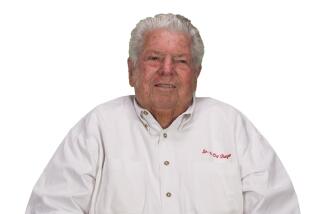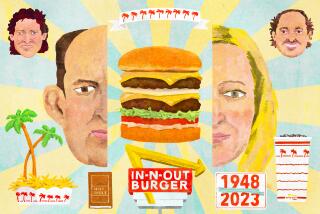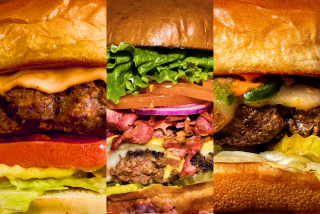Brian Jeffrey Tennyson, 54; Found Heaven in Hamburgers
- Share via
Some like a $6 burger, others go for a double-double, and some settle for two all-beef patties with special sauce. Brian Jeffrey Tennyson loved them all.
And not just the hamburgers, but the restaurants that served them and the advertising images that sold them.
Tennyson, an art director who wrote the 1993 pop-culture paean “Hamburger Heaven: The Illustrated History of the Hamburger,” died Friday at his Palm Springs home.
He was 54, and the cause was liver failure due to complications of HIV, his family said.
Tennyson, known to most as Jeff, grew up in the Midwest fascinated by architecture and the design sensibility of the ‘50s, according to his friend Monte Greges.
“Jeff was always a creative person, very visual,” Greges told The Times on Tuesday. “He liked taking pictures of classic ‘50s buildings, drive-in movie theaters, movie marquees. And hamburger stands like White Castle, the original McDonald’s.
“That led to his collecting hamburger memorabilia. He just started amassing this huge collection.... And he decided since he had so many photos he would do the book.”
A graphic artist and photographer, Tennyson also wrote the text for the book, which sprang from his nostalgia for the drive-in restaurants of his youth.
“Growing up in Michigan in the ‘60s, that was a very fun part of my childhood,” Tennyson told the Milwaukee Journal in 1999. “The hamburger is a big part of who we are. We grew up with it. It’s just part of our lives.”
In a breezy, conversational tone, Tennyson traces the history of the hamburger (roots in Germany, conflicting claims to the first appearance in America) but doesn’t stop there.
The book documents the evolution of fast-food restaurants starting with hamburger stands and sit-down diners and progressing to drive-ins and drive-throughs.
With a wide array of vintage photos, menus and logos, Tennyson chronicles the architecture, signs and service philosophies of the businesses where car culture and fast food converged.
From Rodney Allen Rippy trying to get a grip on a Jumbo Jack in the early ‘70s to Clara Peller grousing, “Where’s the beef?” in the ‘80s, Tennyson reminds the reader of bygone ad campaigns.
For road-trippers he offers suggestions for the perfect burger (Tommy’s and In-N-Out in Southern California, Duane’s Ono Char Burger on Kauai, the Red Rooster in Brewster, N.Y.).
For a time his extensive collection of kitsch was displayed at the Hamburger Hall of Fame in Seymour, Wis., the site of one of the original purveyors of hamburgers.
The museum lost its lease a few years ago and Tennyson’s memorabilia -- vintage posters, fine art creations, books, cigarette lighters, toys, the list goes on and on -- is now mostly in storage. Selected items were displayed at his home in Palm Springs, including his original paintings.
Born in Chicago on July 26, 1952, Tennyson was raised in Niles, Mich. He earned a bachelor’s degree at Bowling Green State University in Ohio, where he majored in art and minored in pop culture. He moved to New York City in 1975 and worked as a magazine art director for After Dark, Skiing and Christopher Street. When he moved to Los Angeles in 1987 he had a contract with Hyperion for the “Hamburger Heaven” book. He was diagnosed with HIV in 1990 and moved to Palm Springs in 1999.
“He really slowed down because of the HIV,” his sister, Lisa Tennyson, told The Times. “In his mind he always wanted to open another museum or burger joint in Palm Springs.”
In addition to his sister, of Massachusetts, Tennyson is survived by his parents, Don and Betty Tennyson of Dowagiac, Mich.
At Tennyson’s request there will be no services. His ashes will be scattered at Indian Lake in Michigan and in Palm Springs. Donations in his name may be made to KCET public television station, 4401 Sunset Blvd., Los Angeles, CA 90027.
More to Read
Sign up for our Book Club newsletter
Get the latest news, events and more from the Los Angeles Times Book Club, and help us get L.A. reading and talking.
You may occasionally receive promotional content from the Los Angeles Times.







